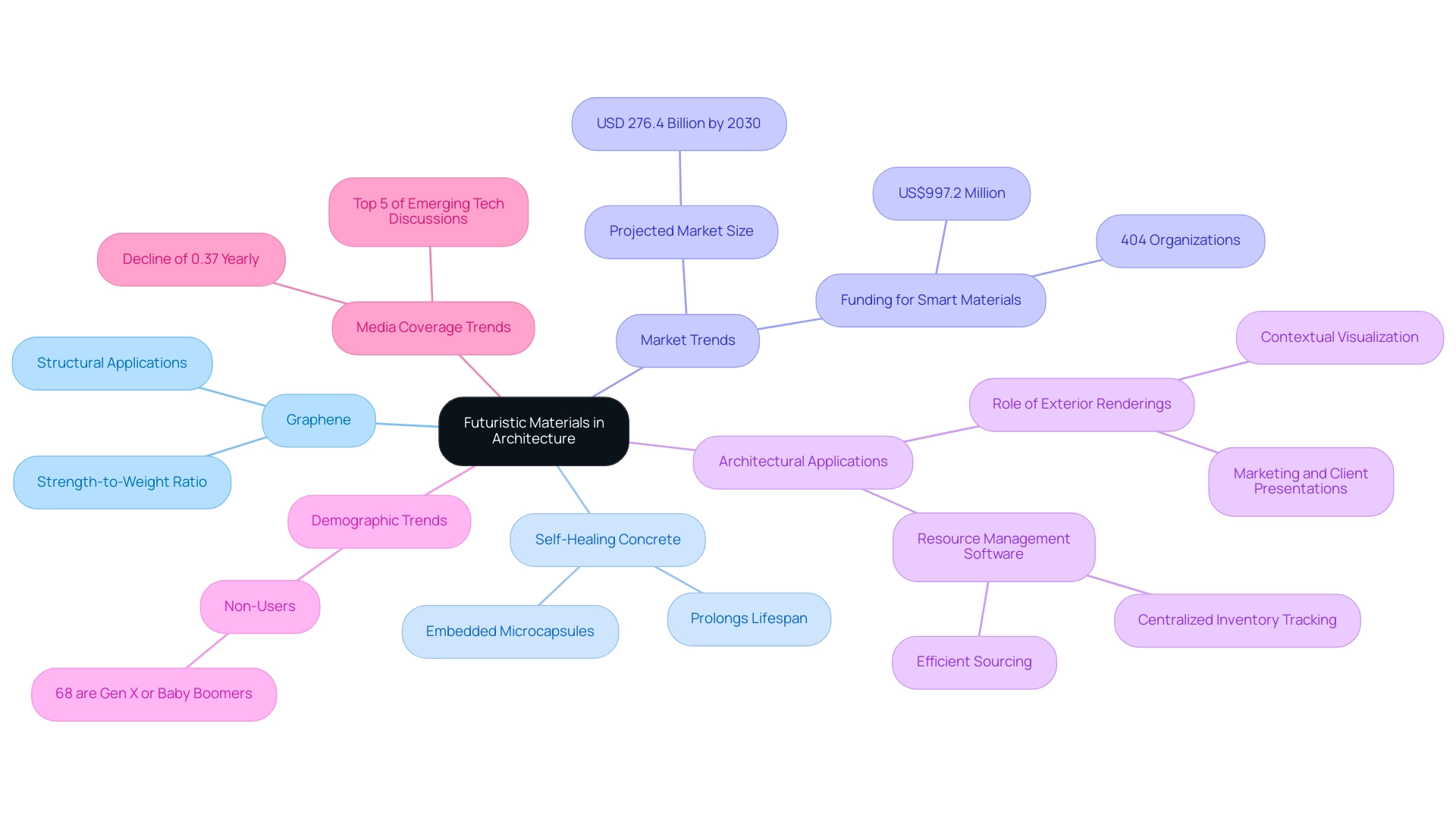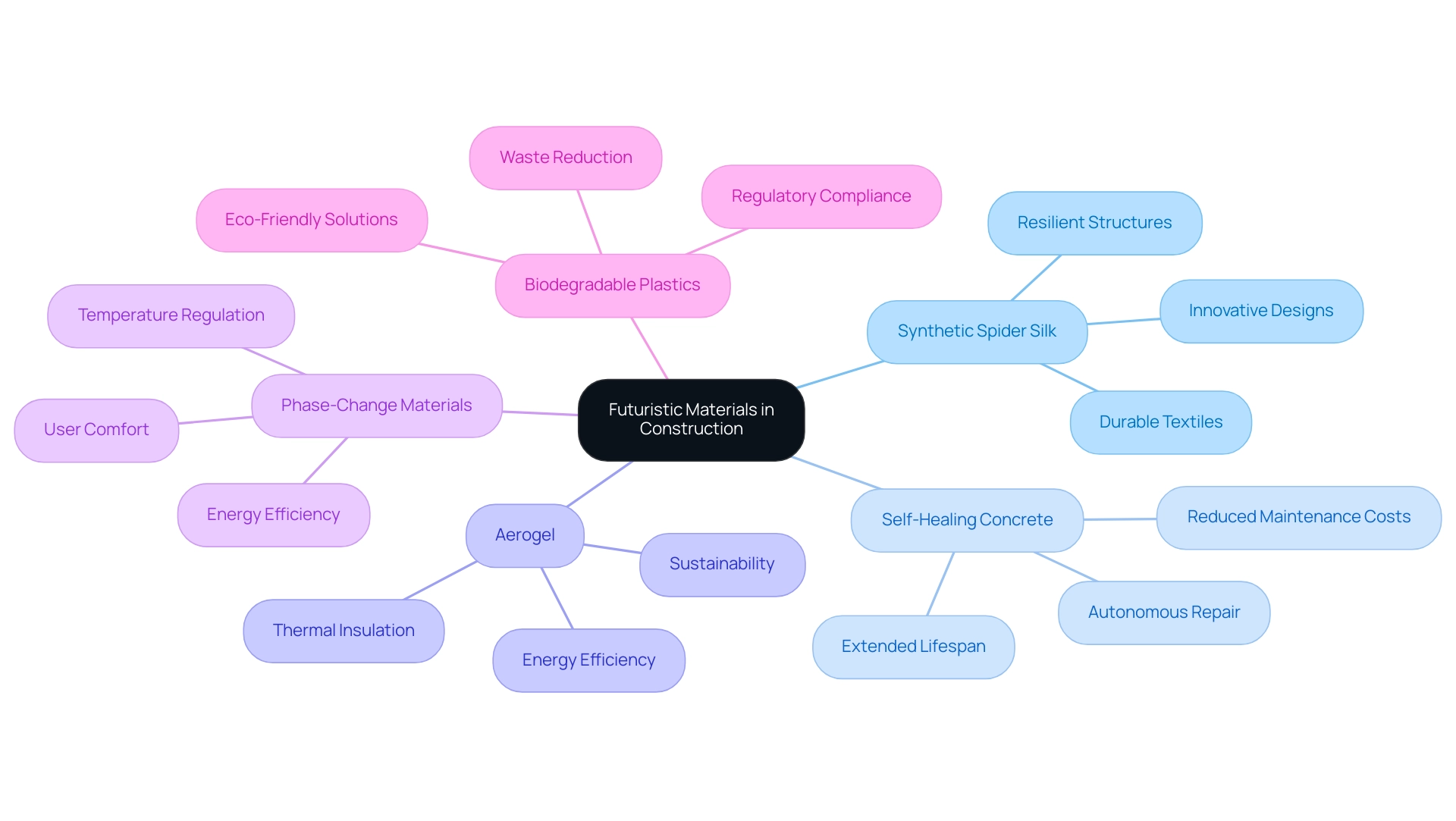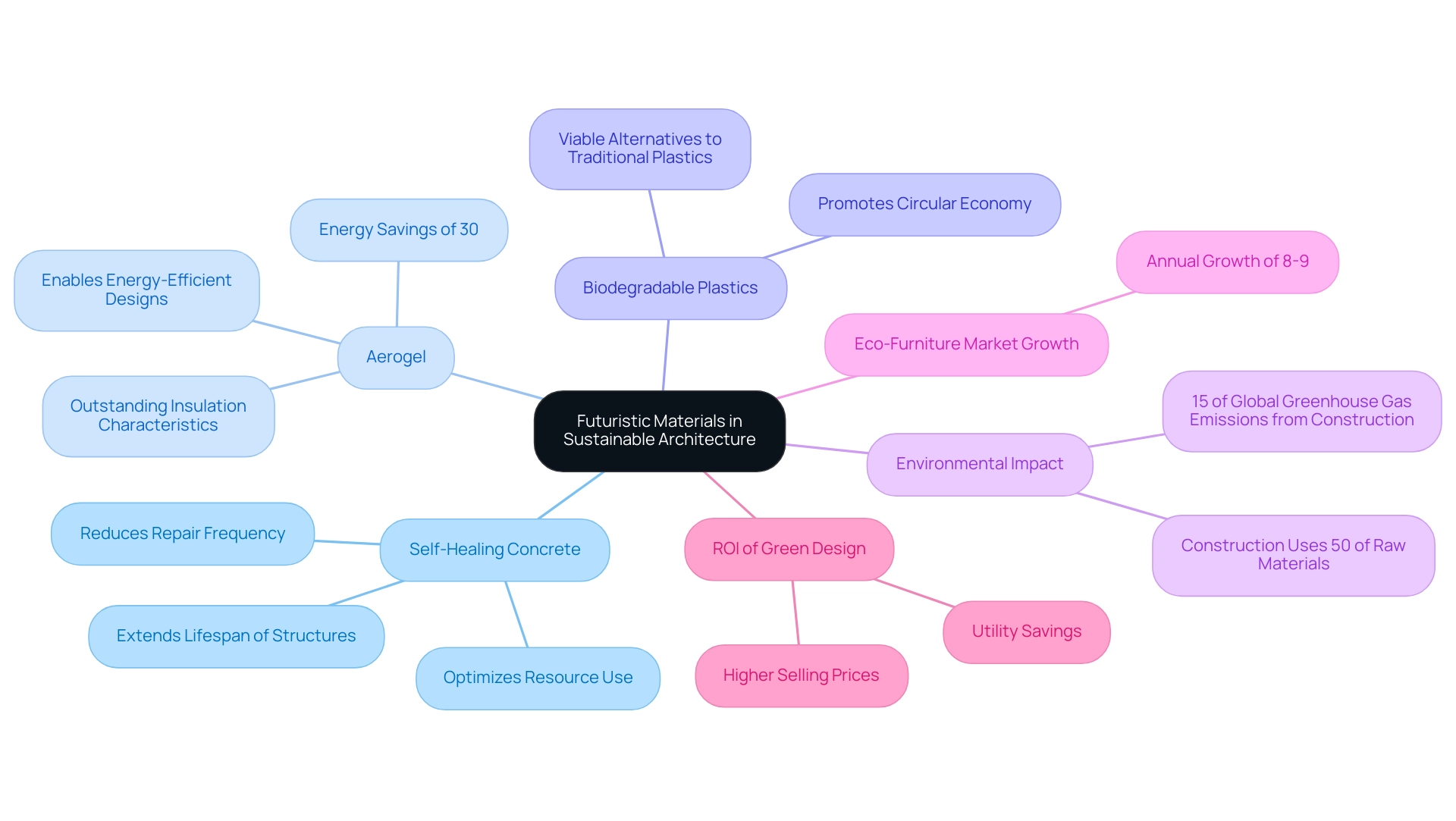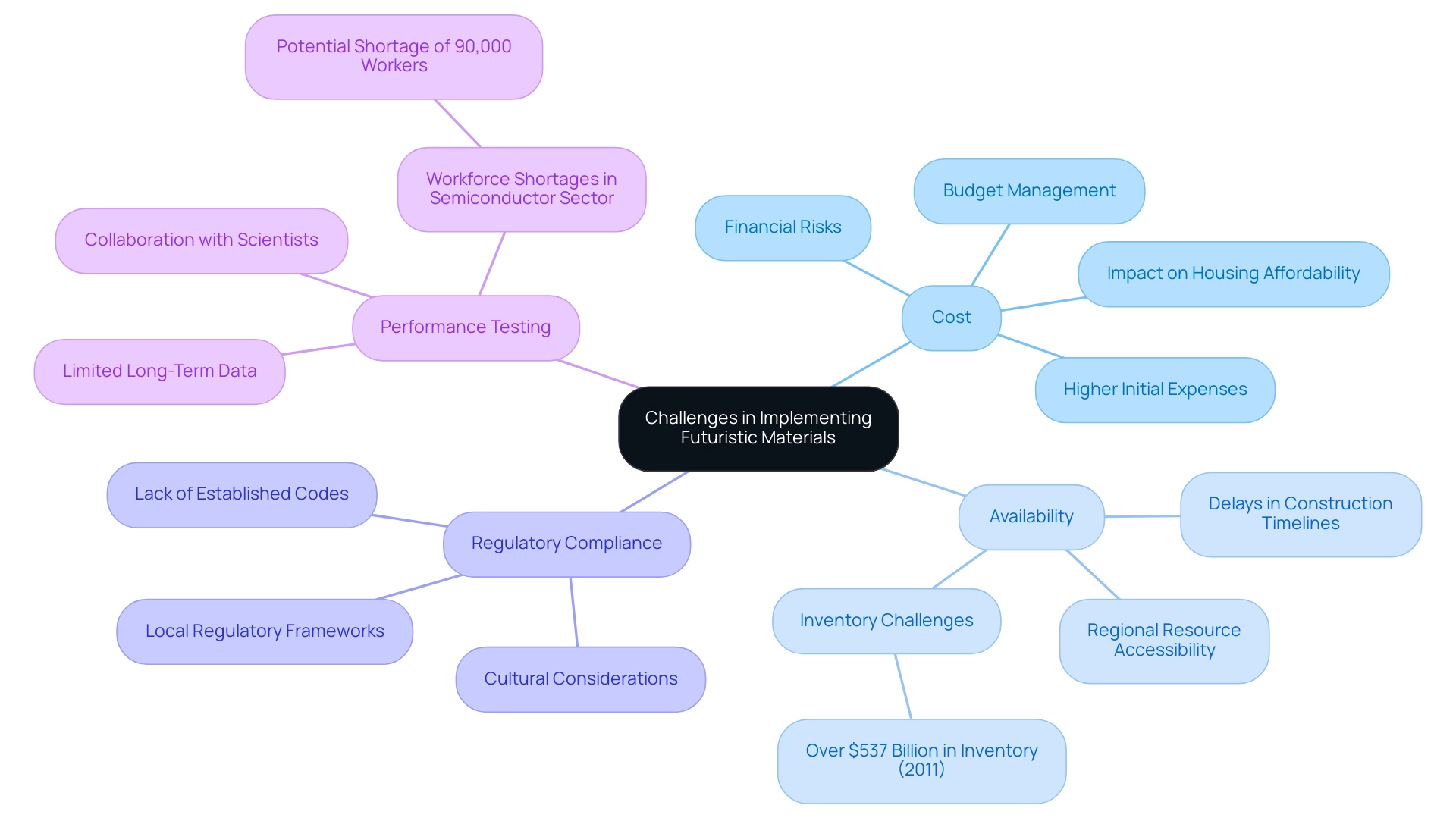Introduction
As the architectural landscape evolves, the emergence of futuristic materials is redefining the boundaries of design and sustainability. These advanced materials not only promise to enhance the structural integrity of buildings but also address pressing environmental concerns, positioning architects at the forefront of innovation.
From the remarkable strength of graphene to the self-repairing capabilities of self-healing concrete, the potential applications are vast and transformative. As the global market for lightweight materials continues to expand, understanding the properties and implications of these innovations becomes essential for architects aiming to create resilient, eco-friendly structures.
This article delves into the latest advancements in futuristic materials, their applications in sustainable architecture, and the challenges architects face in their integration, providing a comprehensive overview of this pivotal shift in the industry.
Exploring the World of Futuristic Materials: Properties and Innovations
Futuristic materials signify a pivotal evolution in architectural design, characterized by extraordinary properties that enhance structural integrity, reduce weight, and promote sustainability. Graphene, for example, is celebrated for its unparalleled strength-to-weight ratio, which positions it as a game-changer in structural applications. Additionally, innovations like self-healing concrete leverage embedded microcapsules that dispense healing agents upon crack formation, effectively prolonging the lifespan of structures and minimizing maintenance expenditures.
As reported, the global lightweight products market is projected to reach USD 276.4 billion by 2030, indicating a robust demand for such advanced solutions. Architects must stay informed about these innovations, utilizing exterior renderings to demonstrate how these substances interact with natural lighting and their surroundings, thereby facilitating a comprehensive contextual visualization. The function of exterior renderings is essential, as they emphasize landscaping features such as trees and pathways, illustrating how the building merges with its surroundings, which increases the attractiveness of innovative components.
Furthermore, exterior renderings play a vital role in marketing, project approval, and client presentations, ensuring that stakeholders can visualize the project’s potential. The increasing interest in futuristic materials, supported by approximately US$997.2 million in funding across 404 organizations, underscores the industry’s commitment to integrating technology into construction. This commitment is reflected in the development of resource management software by SCM, which centralizes inventory tracking and procurement processes, ensuring that architects can efficiently source these innovative resources.
Despite a slight yearly decline of 0.37% in media coverage of the industry over the last decade, the sector remains significant in emerging tech discussions, underscoring its relevance. Furthermore, with 68% of non-users belonging to Gen X or Baby Boomers, grasping demographic trends is essential for architects as they promote the use of these advanced resources. With these advancements, architects are equipped not only to meet contemporary demands but also to redefine the standards of modern architectural practices.
Key Examples of Futuristic Materials and Their Applications
Synthetic spider silk, a cutting-edge bioengineered futuristic material, offers exceptional tensile strength and flexibility, making it an exciting prospect for modern architecture. Material scientists have praised the potential of this futuristic material, stating that it can be utilized not only in lightweight and durable textiles for fashion and sports gear but also in building for creating flexible and resilient structures. Dr. Jane Smith, a prominent scientist in her field, emphasizes, “The adaptability of synthetic spider silk, a futuristic material, can revolutionize our approach to structural design, allowing for innovative solutions that meet client expectations.”
The application of futuristic material in construction is set to expand significantly in 2024, with ongoing research exploring its integration into load-bearing elements that require both strength and adaptability.
Self-healing concrete is a futuristic material that represents a revolutionary advancement in materials science, capable of autonomously repairing cracks as they form. This innovation is especially advantageous for infrastructure projects such as bridges and highways, where futuristic material can reduce maintenance costs and time. By reducing the need for frequent repairs, self-healing concrete offers a substantial decrease in long-term repair costs and operational downtime.
Recent studies indicate that incorporating futuristic material can significantly extend the lifespan of concrete structures, enhancing their overall durability and performance. In fact, a study revealed that self-healing concrete, considered a futuristic material, can reduce repair costs by up to 30%, providing a compelling case for its adoption in modern architecture.
- Aerogel, often referred to as ‘frozen smoke,’ is considered a futuristic material due to its status as one of the lightest solid materials available, exhibiting remarkable thermal insulation properties. The incorporation of futuristic material in energy-efficient building concepts has garnered attention for its ability to significantly reduce heating and cooling expenses. As architects strive for sustainability, the integration of futuristic material such as aerogel into walls and roofing can lead to buildings that meet stringent energy standards while simultaneously enhancing occupant comfort.
This aligns with the growing client demand for eco-friendly solutions, including futuristic materials, in architecture.
- Phase-Change Materials (PCMs)
Phase-change materials are a type of futuristic material engineered to absorb and release thermal energy during phase transitions, making them ideal for regulating indoor temperatures. By incorporating futuristic material such as PCMs into building structures, especially within walls or ceilings, architects can achieve superior energy efficiency and maintain comfortable indoor climates. This technology not only enhances user comfort but also utilizes futuristic material to align with contemporary demands for sustainable building practices, ultimately exceeding client expectations for energy-efficient designs.
With a growing emphasis on sustainability in construction, futuristic materials such as biodegradable plastics derived from renewable resources are gaining traction. These resources, made from futuristic material, are intended to reduce environmental impact while providing the functional performance necessary in construction and packaging. As the industry shifts towards greener alternatives, the use of biodegradable plastics as a futuristic material represents a viable solution for reducing waste and promoting eco-friendly building practices.
This shift not only satisfies regulatory requirements but also resonates with clients increasingly prioritizing sustainability in their projects.
The Role of Futuristic Materials in Sustainable Architecture
Futuristic materials are essential to advancing sustainable architecture, providing innovative solutions that significantly mitigate environmental impact. For instance, self-healing concrete represents a transformative approach, extending the lifespan of structures while reducing the frequency and resource demands of repairs. This not only optimizes resource use but also aligns with the urgent need for sustainable practices, considering that construction currently contributes to 15% of global greenhouse gas emissions, largely due to the cement production process which is responsible for a significant portion of this figure.
Moreover, a futuristic material like aerogel is remarkable for its outstanding insulation characteristics, enabling energy-efficient designs that can produce significant decreases in energy use for heating and cooling. Recent studies indicate that implementing aerogel insulation can enhance energy savings by up to 30%. Biodegradable plastics, as well, have arisen as viable alternatives to traditional substances, promoting a circular economy that further supports sustainability.
The eco-furniture market’s anticipated yearly expansion of 8-9% highlights a wider movement towards sustainable resources in architecture. By incorporating these innovative elements into their architectural concepts, professionals can create structures that are both visually impressive and ecologically responsible. As noted by the National Association of Realtors, ‘We should educate clients on the ROI of green design, from higher selling prices to utility savings,’ highlighting the tangible benefits of adopting sustainable practices.
Ultimately, these efforts contribute to a more sustainable built environment.
Challenges and Considerations in Implementing Futuristic Materials
The incorporation of futuristic substances into contemporary architecture presents a host of advantages, yet it is imperative to acknowledge several key challenges that may arise:
Cost: Advanced construction resources often involve higher initial expenses compared to conventional alternatives, which can present considerable obstacles for budget-conscious endeavors. Architects are tasked with performing a comprehensive cost analysis, weighing the long-term benefits against upfront expenditures to ensure that the investment is justified. As emphasized in a case analysis, escalating expenses due to higher resource prices are inflating budgets, leading to delays, cost overruns, and financial risks for contractors, ultimately impacting housing affordability. Providing clear specifications and timely information can mitigate these risks, ensuring smoother financial planning. Timely discussions regarding resource options—whether from detailed 100-page building sets or simple napkin sketches—can greatly impact results and budget management.
Availability: The accessibility of certain innovative resources varies significantly by region. This inconsistency can lead to delays in the work, necessitating thorough research into local suppliers and proactive planning to avoid setbacks in construction timelines. The National Institute of Standards and Technology reported that over $537 billion was tied up in inventory in 2011, indicating potential challenges in resource availability that architects must navigate. Efficient communication regarding resource requirements early in the initiative can simplify procurement processes and avoid delays, emphasizing the significance of clarity in specifications.
Regulatory Compliance: The introduction of new substances into the construction sphere often lacks established building codes or regulations, complicating their implementation. Architects must remain vigilant and well-informed about local regulatory frameworks to ensure compliance and mitigate potential legal challenges. Furthermore, the significance of national originality and ethnocultural identity in architecture should be taken into account when choosing resources, as these elements can affect regulatory acceptance and project success. Clearly documenting specifications can facilitate the compliance process, emphasizing the need for early and precise communication.
Performance Testing: A notable challenge is the limited availability of long-term performance data for many futuristic materials, which complicates their assessment for specific applications. To address this, architects should engage in rigorous performance testing and collaborate with scientists to validate the substances’ suitability for intended uses. Additionally, the semiconductor industry might encounter a shortage of as many as 90,000 workers in the coming years, which could affect the availability and progress of advanced substances. By ensuring timely communication regarding testing and validation processes, architects can better manage expectations and timelines.
By proactively identifying and addressing these challenges, architects can navigate the complexities associated with adopting futuristic materials, ultimately enhancing their design capabilities and leading to innovative architectural solutions. The importance of providing the right information early cannot be overstated, as it directly correlates to optimizing time and cost in construction projects.
Conclusion
The exploration of futuristic materials marks a significant turning point in architectural design and sustainability. Innovations such as graphene, self-healing concrete, and synthetic spider silk are not only enhancing structural integrity but also paving the way for more eco-friendly building practices. These materials, characterized by their remarkable properties, are essential in addressing the pressing environmental challenges faced by the construction industry, which contributes significantly to global greenhouse gas emissions.
As architects embrace these advancements, they must also navigate the inherent challenges, including:
- Cost
- Availability
- Regulatory compliance
- Performance testing
A thorough understanding of these factors is crucial for successful integration into architectural projects. By performing comprehensive cost analyses and ensuring effective communication regarding material specifications, architects can mitigate risks and enhance project outcomes.
Incorporating futuristic materials into architectural practices not only aligns with the growing demand for sustainability but also positions architects as leaders in innovation. The shift towards these advanced solutions reflects a commitment to creating structures that are not only visually appealing but also environmentally responsible. Ultimately, the adoption of these materials will redefine modern architectural standards, fostering a built environment that is resilient, sustainable, and equipped to meet the demands of future generations.




0 Comments